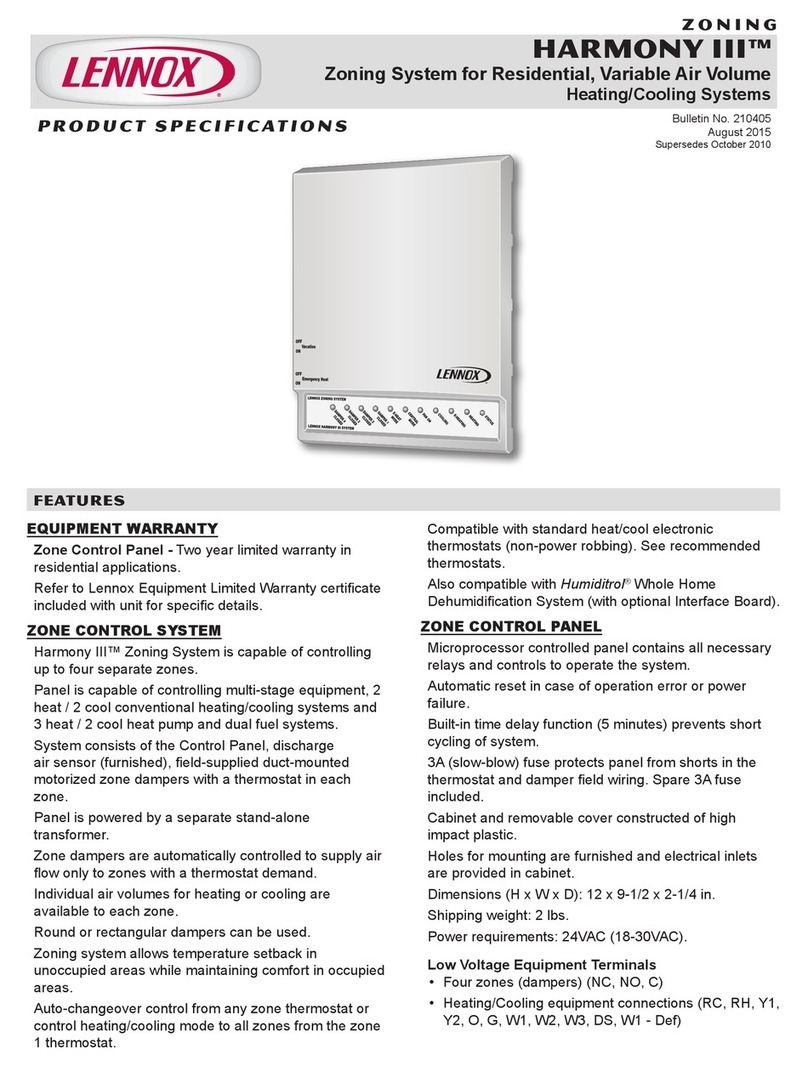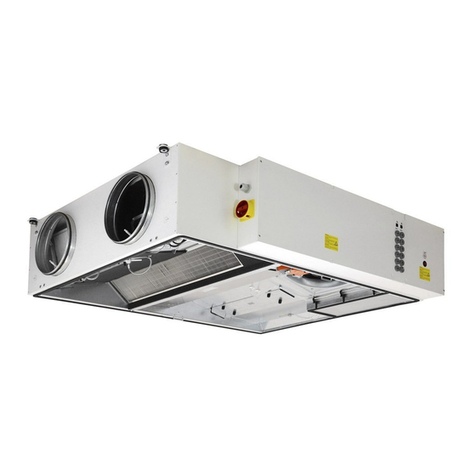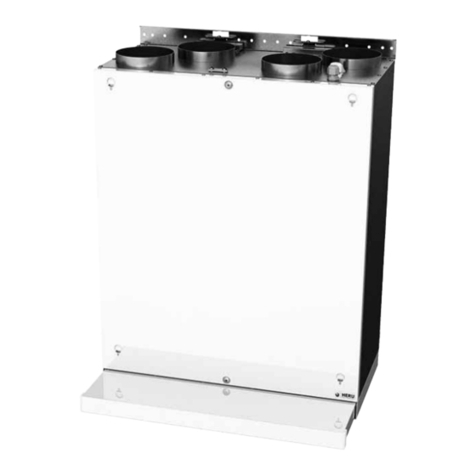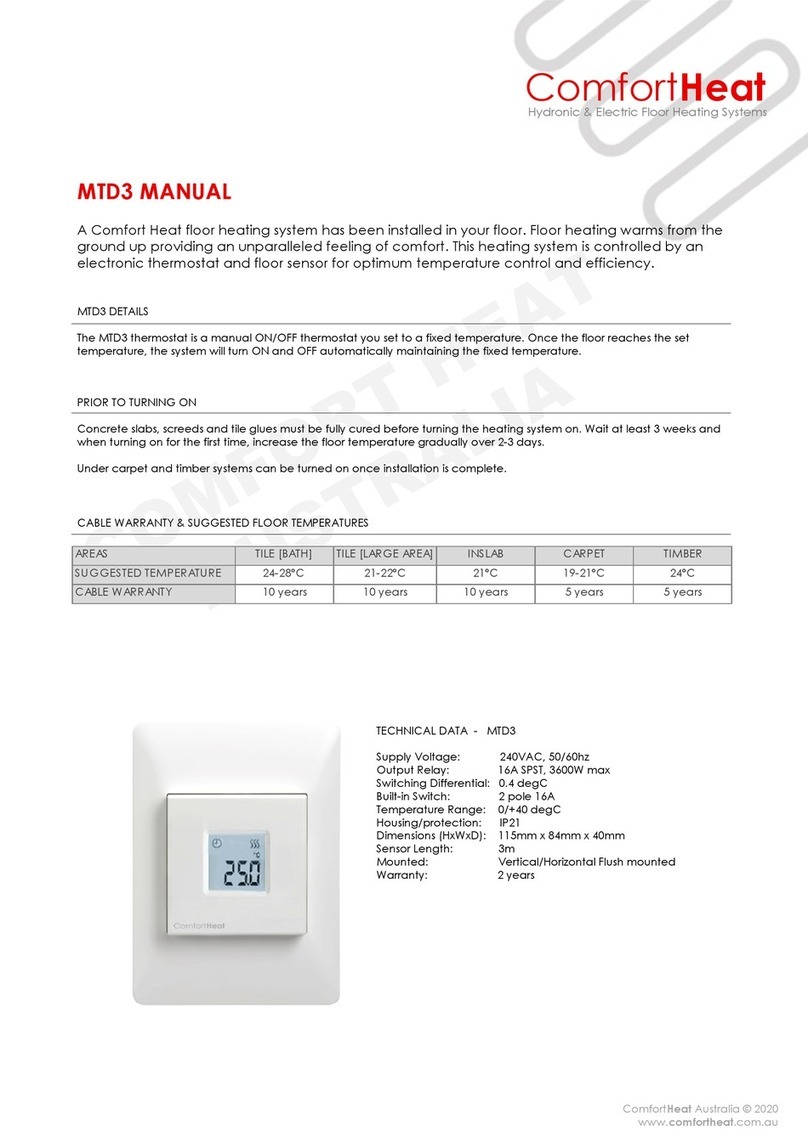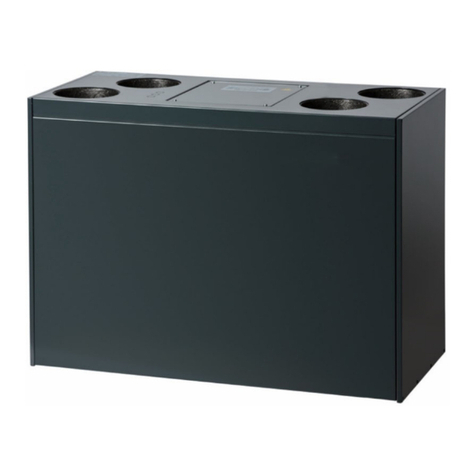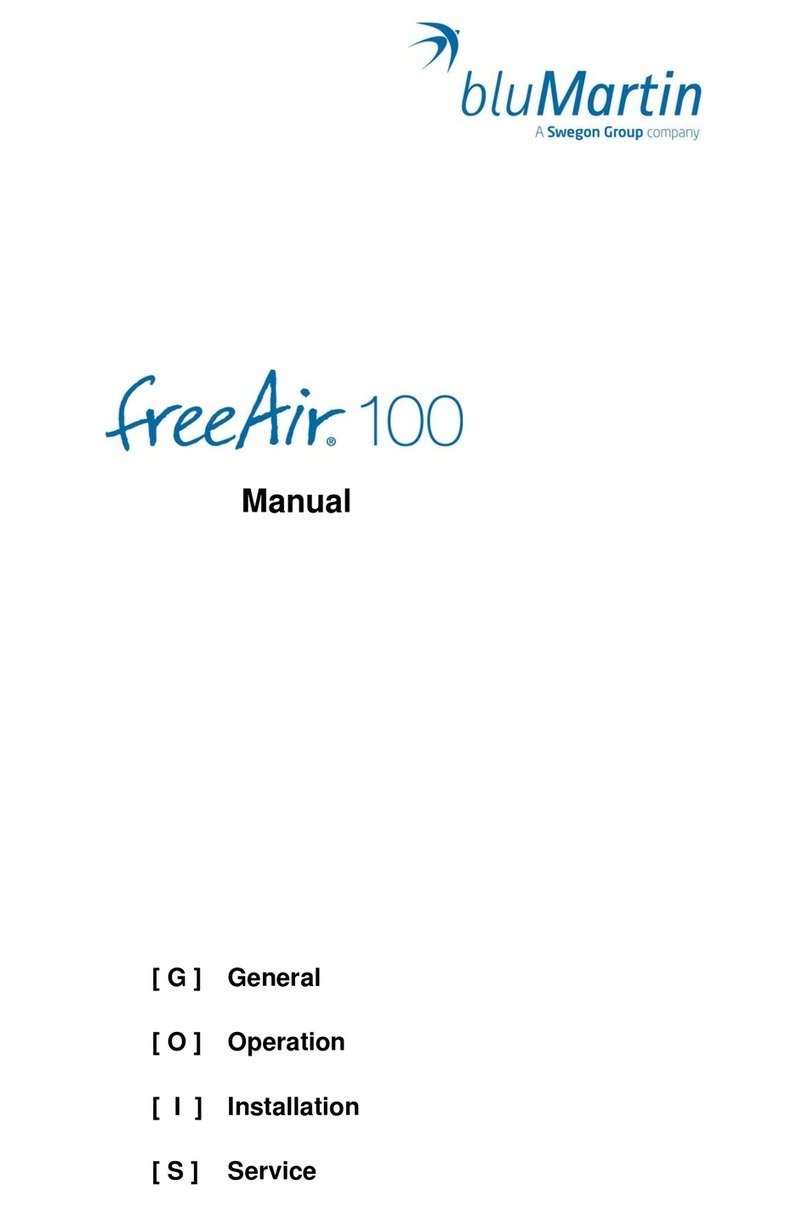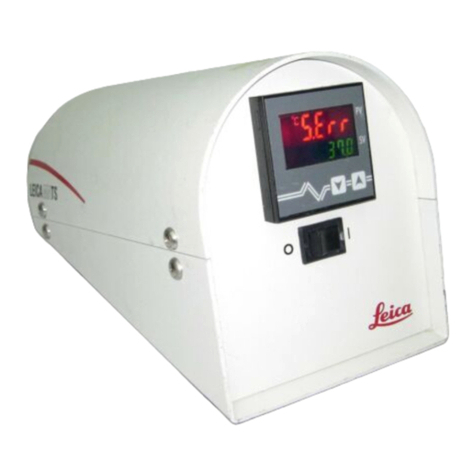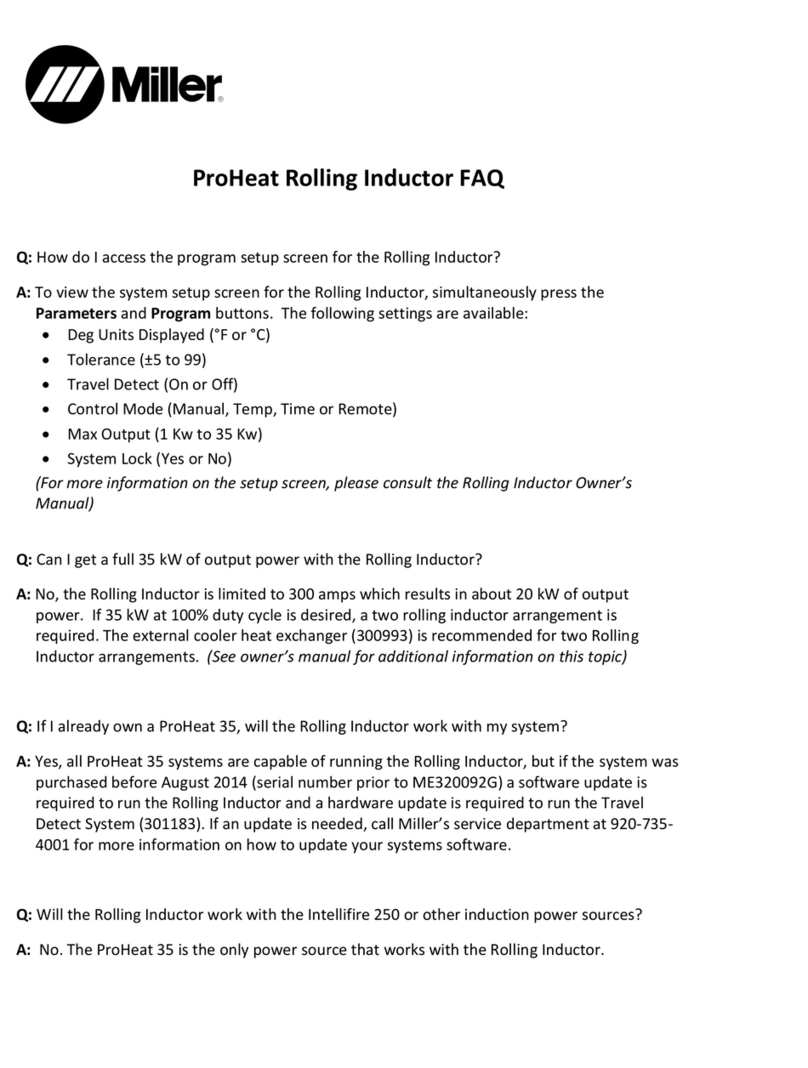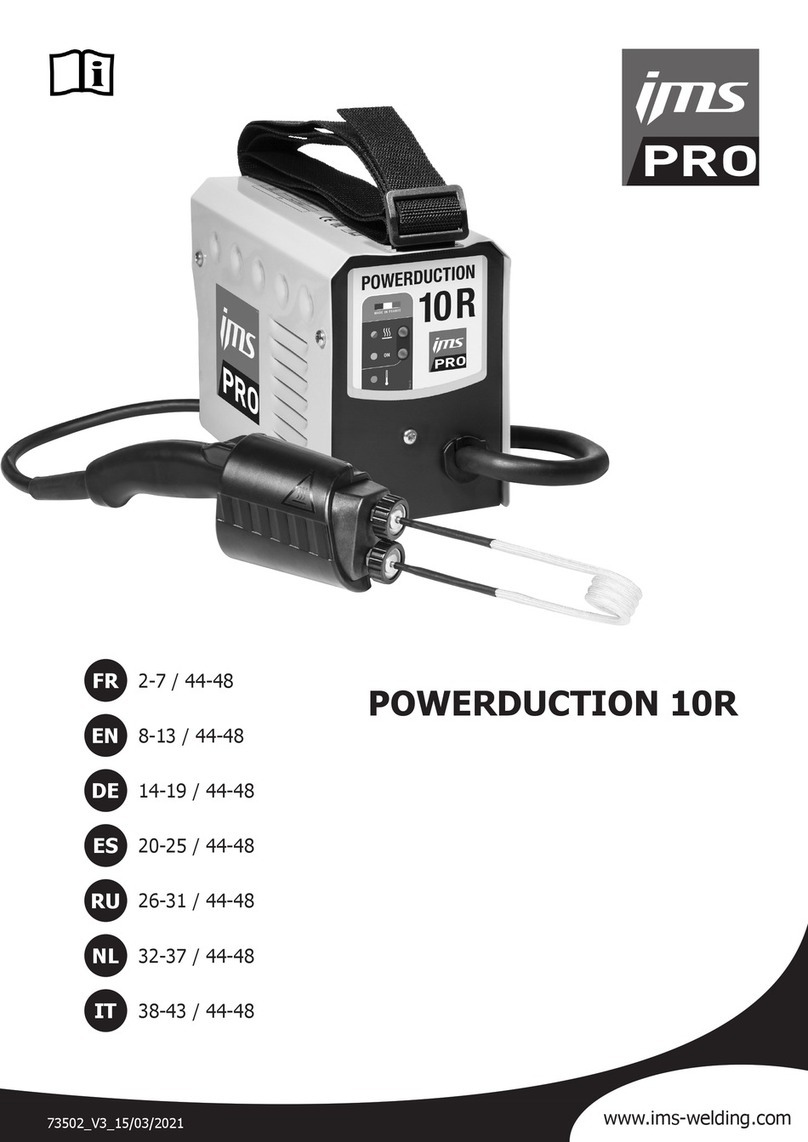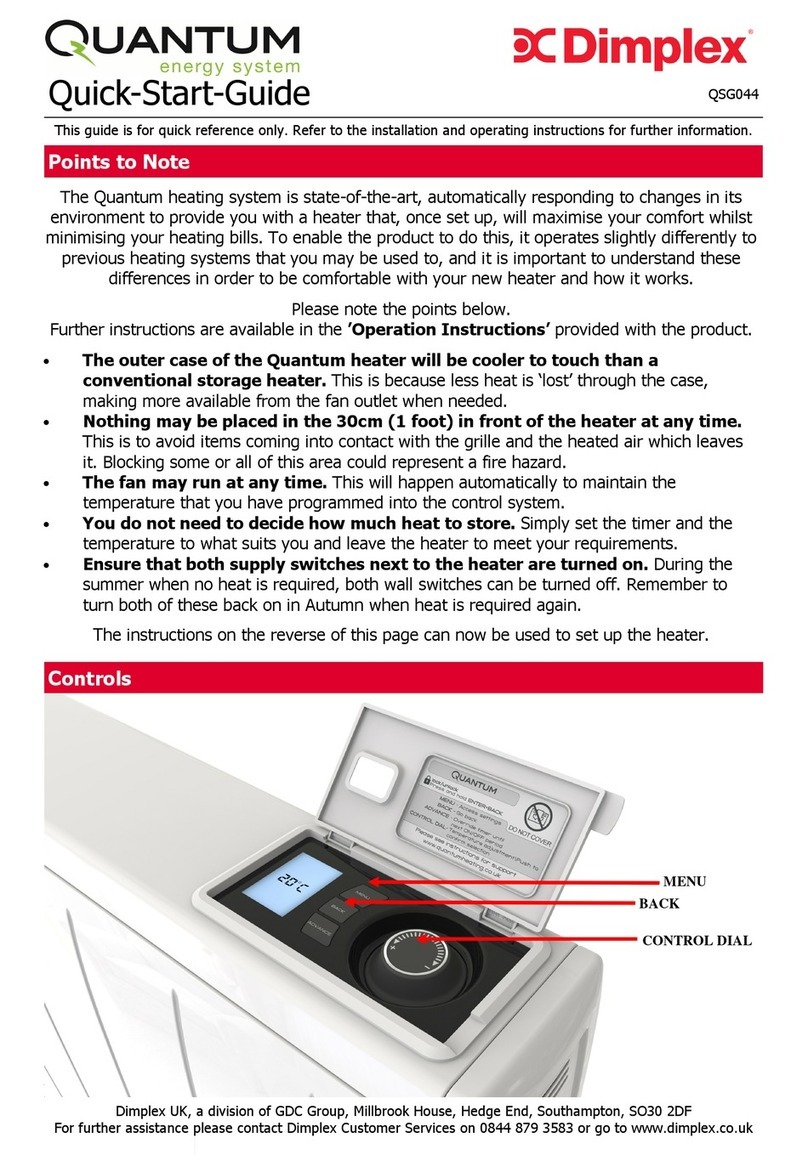Nordyne CMF80-PG Operating instructions

Owners Manual/Installation Instructions
CMF80-PG Convertible (65, 75, and 90 KBTU/H Inputs),
CMF 100-PG (90 KBTU/H Input)
CMF80-PO Convertible (65, 75, and 90 KBTU/H Inputs),
CMF 100-PO (90 KBTU/H Input)
Counterflow Gas or Oil Heating Appliance
Read all instructions carefully before beginning the installation. Read all labels and tags
on the furnace carefully and follow all precautions outlined on those labels and tags.
FOR YOUR SAFETY
Do not store or use gasoline or other
flammable vapors and liquids in the
vicinity of this or any other appliance.
!
WARNING:
Improper installation, alteration, ser-
vice or maintenance can cause injury
or property damage. Refer to this
manual for assistance or consult a
qualified installer, service agency, or
the gas supplier for additional infor-
mation.
FOR YOUR SAFETY
WHAT TO DO IF YOU
SMELL GAS
• Do not try to light any appliance.
• Do not touch any electric switch; do not
use any phone in your building.
• Immediately call your gas supplier from a
neighbor’sphone.Followthegassupplier’s
instructions.
• If you cannot reach your gas supplier, call
the fire department.
Rated CMF-PG CMF-PO CMF-PG CMF-PO
BTUH 80 CONV. 80 CONV. 100 100
Input 75,000 75,000 90,000 90,000
Output 56,000 60,000 68,000 72,000
GENERAL
CMF furnaces are high quality, direct vent
furnaces used for manufactured housing, rec-
reational vehicle, and residential†applications.
These furnaces are offered in either power gas
(designated by PG) or power oil (designated by
PO) models. The power gas models are de-
signed for operation with either natural or pro-
pane (LP) gas.
The CMF series is convertible from power oil to
power gas, and vice versa. Furthermore, the
firing rate of the CMF80 Convertible Series can
be changed using a certified NORDYNE
conversionkitfield-installedbyaqualifiedservice
technician. Refertothe“FiringRateConversion”
section later in these instructions for more
information on the firing rate change.
These furnaces are certified to the UL307
standards (UL 307A for oil models; UL 307B for
gasmodels),andcanbeinstalledinavarietyof
applications,asshowninTable1. Thisfurnace
is not to be used for temporary heating of
buildings or structures under construction.
!WARNING:
This furnace must be installed by a quali-
fied installing agency and in accordance
with applicable local codes and ordi-
nances that govern this type of equip-
ment. Failure to properly install the fur-
nace, base assembly, and venting sys-
tem as described herein may damage the
equipment and/or the home, can create a
fire or asphyxiation hazard, violates U.S.
listing requirements, and will void the
warranty. This furnace is NOT approved
for installation with split system air con-
ditioning. Use a NORDYNE packaged air
conditioning system.

2
!WARNING:
Do not use this appliance if any part has
been submerged under water. Immedi-
ately call a qualified service technician to
inspect the appliance and to replace any
part of the control system and any gas
control that has been submerged under
water.
INSTALLATIONREQUIREMENTS
Equipment Check
All units are securely packaged at the time of
shipment and should be carefully inspected
upon arrival for damage. Claims for damages
(apparent or concealed), shortage in shipment,
ornondeliveryshouldbefiledimmediatelyagainst
the carrier by the consignee. The carrier is
responsible for making prompt inspection of
damage and for a thorough investigation of
each claim. The manufacturer will not accept
claims for transportation damage.
Requirements and Codes:
Installershallbefamiliarwithandcomplywithall
codes and regulations and applicable to the
installation of these heating appliances and
related equipment.
All manufactured housing installations must
conform with these instructions, all applicable
local codes, ANSI Z223.1/NFPA 54 (National
Fuel Gas Code), ANSI/NFPA 31 (Installation of
Oil Burning Equipment), ANSI/NFPA 70
(National Electrical Code), the Manufactured
Home Construction and Safety Standard, Title
24 CFR, part 3280, or when this standard is not
applicable,thestandardforManufacturedHome
Installations (Manufactured Home Sites,
Communities, and Set-ups), ANSI 225.1.
All residential installations (Refer to Table 1)
must conform with these instructions, all
applicable local building codes, ANSI Z223.1/
NFPA 54 (National Fuel Gas Code), ANSI/
NFPA31(InstallationofOil-BurningEquipment),
ANSI/NFPA70 (National Electrical Code), and
NFPA 211 (Chimneys, Fireplaces, Vents, and
Solid Fuel-Burning Appliances).
The National Fuel Gas Code is available by
writing:
American National Standards
Institute, Inc.
1430 Broadway
New York, NY 10018
NFPA publications are available by writing:
National Fire Protection Association
Batterymarch Park
Quincy, ME 02269
Combustion Air and Ventilation
Requirements
Provisions for adequate combustion air and
ventilation air must be in accordance with the
ANSI Z223.1/NFPA 54, (National Fuel Gas
Code),ANSI/NFPA31(InstallationofOilBurning
Equipment), and all applicable local codes.
Depending upon the type of installation (See
Table 1), the CMF furnace can draw the
combustion air either from outside the home
(directvent)orfromthespacebeingconditioned.
A direct vent system is one in which the flue
products are exhausted to and the combustion
air is drawn from outside the house. A direct
vent system can also be referred to as a sealed
combustion system.
Type of Ducted Direct Vent Furnace Flue Products
Installation Application System Required Base Used Exhausted By
Manufactured
Housing or Yes Yes
Recreational Vehicle MA-100 or MA-200 NORDYNE SRJ Roofjack or
Universal Base an Existing Chimney*
CB-200A Cottage NORDYNE SRJ Roofjack or
Base an Existing Chimney*
CB-200A Cottage NORDYNE SRJ Roofjack or
Base an Existing Chimney*
†Residential is only defined as a single-story non-manufactured housing installation.
*Refer to the "Venting Requirements" section later in these instructions for more details on properly venting this appliance
throu
g
h an existin
g
chimney.
MA-100 or MA-200
Universal Base NORDYNE SRJ
Roofjack Only
Yes
No
Yes
Yes
Residential
†
Residential
†
Residential
†
Yes
No
Table 1

3
Fordirectventapplicationseitherthecombustion
air duct provided with the MA Series base kit or
the direct vent kit can be used. The direct vent
kit must be ordered separately. Only for a
special CB-200A cottage base installation can
the CMF draw the combustion air from the
conditionedspace. TheCB-200Acottage base
kit must be ordered separately. Refer to the
replacement parts listing provided with the
furnacetoorderthedirectvent kitorthe cottage
base kit. Follow the instructions provided with
the kits for proper installation.
When unsure about combustion air supply
availability, a direct vent system should be
used. For small rooms, confined spaces, tight
construction or similar situations in which the
combustion air requirements of the furnace
might not be met, a direct vent system must be
used. Theairopeningsinthedooroftheunitand
the warm air registers from the ductwork or
base must not be restricted.
Combustion air must not be drawn from a
contaminated atmosphere. Excessive
exposure to contaminated combustion air will
result in safety and performance related
problems. Some examples of chemical
contaminants are chlorine, fluorine, and sulfur,
which can be found in a wide variety of some
common commercial and household products.
The installation of the furnace must allow for an
adequate supply of combustion air. The
combustion air opening of the furnace must be
designed and located to prevent blockage by
snow.
When drawing the combustion air from
underneaththehome,ensurethataventorduct
of at least 18 square inches of free area is
providedfromoutside. Checktoensurethatthe
combustion air opening is unobstructed. When
using the combustion air duct, ensure that it
extends through the floor. When using the
direct vent kit, the combustion air opening must
belocatedinthesamepressurezoneastheflue
exit of the roof jack or chimney. Refer to the
instructions provided with the direct vent kit for
more information.
Venting Requirements — Manufactured
Housing Installations
For all manufactured housing applications, the
CMF furnace must be vented using the SRJ
series roofjack. The instructions for selecting
the proper roofjack for your installation are
detailed later in these instructions.
Venting Requirements — Residential
Installations
!WARNING:
This furnace is not to be connected to a
chimney flue serving a separate appli-
ance designed to burn solid fuel.
For residential applications (Refer to Table 1),
the CMF furnace may be vented through the
SRJ series roofjack or through an existing
chimney. Ifthe SRJ roofjack is to be used, then
theinstructionsfor selectingtheproper roofjack
for your installation are detailed later in these
instructions. If venting through an existing
chimney,thentheventingsystemusedmustbe
in accordance with these instructions, all
applicable local building codes, ANSI Z223.1/
NFPA 54 (National Fuel Gas Code), ANSI/
NFPA31(InstallationofOil-BurningEquipment),
and NFPA 211 (Chimneys, Fireplaces, Vents,
and Solid Fuel-Burning Appliances).
!WARNING:
When venting through a chimney, check
the chimney for soot, leaks, obstruc-
tions, and proper installation.
The materials used to construct the venting
system must be capable of withstanding
exposuretotemperaturesofatleast700degrees
F. The existing chimney servicing this furnace
must be vertical. Horizontal distances to an
existing chimney must be as short as possible,
and the connecting pipe must slope upward to
the chimney at not less than a 45 degree angle.
The total length of the sloping pipe must not
exceed 6 feet. The venting system must have
no obstructions or sharp bends where soot and
other foreign matter can accumulate.
If an inspection determines that the chimney is
obstructed, the chimney must be cleaned.
Furthermore, the connecting flue pipe must be
cleaned or replaced.
For ONLY a CMF power oil furnace installation
vented into an existing chimney, a barometric
damper can be installed at the vent connection
ofthefurnacetoregulatethedraft. Thebarometric
damper must be properly installed per the
manufacturer’s instructions. Refer to all
applicable codes to determine whether or not a

4
barometric damper can be used for your CMF
power oil furnace installation. The barometric
damper used must be installed such that air
from the conditioned space can only enter the
flue passageway. Do not use a double acting
barometricdamper. Allfluepipejointsshouldbe
fastened with sheet metal screws for rigidity.
Thechimneyheight,requireddraft,andnumber
of appliances served by the chimney must be
in accordance with all applicable codes. To
prevent down draft, the chimney should extend
at least two feet above the peak of the roof.
It is recommended that the furnace flue serve
nootherappliances. Whenthechimneyserves
only the furnace, the flue area must be sized
accordingtoallapplicablecodes. Theminimum
internalareaofthefluemustbeequaltoatleast
the area of the furnace flue exit.
Whentwoormoreappliancesmustventthrough
a common flue, the area of the common flue
shouldbesizedinaccordancewithallapplicable
codes.
Whenanexistingfurnaceisremovedorreplaced
in a venting system, then the venting system
may not be properly sized to vent the attached
appliances. The venting system must be
checked to ensure proper venting. Improperly
sizedventingsystemscanresultintheformation
of condensate, leakage, spillage, et cetera.
Refer to the ANSI Z223.1/NFPA 54, (National
FuelGasCode),andANSI/NFPA31(Installation
of Oil Burning Equipment) for correcting any
improperly operating venting system.
The following steps shall be followed with each
appliance connected to the venting system
placed in operation, while any other appliances
connected to the venting system are not in
operation:
(a) Seal any unused openings in the venting
system.
(b) Inspect the venting system for proper size
and horizontal pitch, as required in the
ANSIZ223.1/NFPA54,(NationalFuelGas
Code) and ANSI/NFPA 31 (Installation of
Oil
Burning Equipment), and these instruc-
tions. Determine
that there is no blockage or restriction,
leakage, corrosion
orotherdeficiencieswhichcouldcausean
unsafe condition.
(c) In so far as is practical, close all building
doors and windows and all doors between
the space in which the appliance(s) con-
nected to the venting system are located
and other spaces of the building. Turn on
clothes dryers and any appliance not con-
nectedtotheventing system. Turnon any
exhaust fans, such as range hoods and
bathroom exhausts, so they shall operate
at maximum speed. Do not operate a
summer exhaust fan. Close fireplace
dampers.
(d) Follow the lighting instructions. Place the
appliance being inspected in operation.
Adjustthermostat so applianceshall oper-
ate continuously.
(e) Test for draft hood equipped appliance
spillage at the draft hood relief opening
after 5 minutes of main burner operation.
Use the flame of a match or candle.
(f) After it has been determined that each
appliance connected to the venting sys-
tem properly vents when tested as out-
lined above, return doors, windows,
exhaust fans,fireplace dampers and any
other gas burning appliance to their previ-
ous conditions of use.
Flashing
Barrel
Ceiling Plate
Vent
Ventilation
Knock-Out
DUCT
CONNECTOR
Return Air
Grille and
Filter
Power Supply
Connection
Access
Door
Base Pan
Fuel Line
Feeder Duct
Combustion
Air Duct
FURNACE
ASSEMBLY
ROOF JACK
ASSEMBLY
Combustion Air
Adapter (Not Shown)
is to be Installed
Over Combustion
Air Duct
Figure 1. Typical Furnace Installation for
Manufactured Housing Applications

5
(g) If improper venting is observed during any
of the above tests, the venting system
must be corrected.
Unit Location and Clearance to Adjacent
Material Requirements
Theunitmustbeinstalledinalevelposition. The
furnace must be installed with the minimum
clearancesfrom adjacent materials as stated in
Table2. Additionalclearanceshouldbeprovided
to permit servicing of filters, blower, motors,
controls, combustion air connections, and vent
connections.
UNIT INSTALLATION
These instructions are intended for the use of
qualified individuals specially trained and
experiencedininstallationofthistypeequipment
and related system components. Installation
and service personnel are required by some
governing bodies to be licensed. Persons not
qualified should not attempt to install this
equipment or interpret these instructions.
MA-200 Base Installation
The MA-200 base is designed for O.E.M. and
replacement installation of the CMF series fur-
nace (see Figures 2 and 3). The warm air duct
system should be designed so the duct static
pressure external to the furnace does not
exceed the static pressure listed on the furnace
data label.
Use the base pan to mark the 12-1/8" x 12-1/
8"centeropeningforthefeederduct. Whenthe
4" offset feeder duct is used, the floor opening
will be offset 4 inches from the opening in the
main duct. If using the combustion air duct,
select and knock out the combustion air open-
ing to be used. Then mark the 2-1/4" x 7-1/4"
opening for the combustion air duct.
Cuttheopeningforthefeederduct14-1/8"x14-
1/8" in flooring (cutting opening 1" larger all the
waywillallowtheflangesontheundersideofthe
base pan to fit in the opening).
Ifusingthecombustionairduct,cuttheopening
for the duct about 1/8" larger than the marking
onthefloor. Besuretocutthroughallinsulation
andthebottomboardsothatthecombustionair
duct is unobstructed to outside air.
Drillanapproximate1"diameterholeforthefuel
line through the floor and bottom board to the
outside. Fuel lines are not supplied with the
furnace. They should be installed to comply
with all applicable codes.
Drop transition or offset feeder duct upside
down through the floor opening and center the
top of the feeder duct in 14-1/8" x 14-1/8" floor
opening. Usingthefeederductasaguide,mark
and cut a 12" x 12" opening in the distribution
duct. (See Figure 3)
Insert the feeder tabs into the main duct and
bend them over tightly so that the main duct
edges are trapped between flanges and tabs.
Metal tape may also be used to ensure an air
tight connection.
** See Item K in the "Closet Installation of
Furnace" section later in these instruc-
tions for clearance less than 6".
Table 2. Minimum Clearances
to Adjacent Materials
Closet Alcove
ALL MODELS Installation Installation
Sides 0" 0"
Back 0" 0"
Front 6"** 18"
Top 17" 17"
Vent 6" 6"
Ductwithin 3’from Furnace 1/4" 1/4"
Plenum 1" 1"
Roof Jack Barrel 0" 0"
Figure 2. MA-200 Base Pan
FRONT
7-1/8 X 2-3/16 Knock-outs
Combustion Air
Feeder Duct
Opening
Flue
Location
24-1/8
8-3/8
12-1/8
12-1/8
9-1/8 18-1/4

6
Installthe base pan around the feeder duct with
the (2) screws through the holes towards the
rear of the base pan.
Slit the corners of the feeder duct down to the
top of the base pan. While the top of the
distributionductispulledupwithonehand,bend
down each side of the feeder duct tightly to the
basewiththeotherhand. Trimthemetaltoallow
a one inch flange over the top of the base pan
and seal that flange with the metal tape.
If a “V”or “U”-box crossover system is to be
used, see the instructions provided with the
crossover system.
Figure 4. MA-100 Universal Base,
Bottom Panel
12-1/8
12-1/8
Feeder Duct
Opening
7-1/8 X 2-3/16 Knock-outs
Combustion Air
18-1/4
24-1/2
Figure 5. Feeder Duct Installation
Heat Duct Below Joists
Base Feeder Duct
Floor
Joists
Cut This Line
Bend Over
Along This Line
1"
Figure 3. Transition and Offset Ducts
Heater Duct Below Joists
Flange
Bend Over Tabs
Base
Floor
Joists
Slit 4 Corners Bend Down 4 Sides
TRANSITION
DUCT
Floor
Joists
Heater Duct Below Joists
Bend Over Tabs
Flange
Slit 4 Corners
Base
Bend Down 4 Sides
MA-100 Universal Base Installation
The MA-100 base is designed primarily for
replacement installation of the CMF series fur-
nace where the manufactured home duct sys-
tem may be small and restrictive to proper air
flow. The MA-100 base provides approxi-
mately four (4) inches of additional plenum
spacebeforethedischargeairentersthemanu-
factured home duct system. (See Figures 4
and 5)
Use the bottom panel of the base assembly to
mark the 12-1/8" x 12-1/8" center opening for
thefeederduct. Ifusingthecombustionairduct,
select and knock out the combustion air open-
ing to be used. Then mark the 2-1/4" x 7-1/4"
opening for the combustion air duct.
Cuttheopeningforthefeederduct14-1/8"x14-
1/8" in flooring (cutting opening 1" larger all the
way around 12-1/8" x 12-1/8" template mark-
ing). This will allow the four flanges on the
underside of the panel to fit into the opening.
Ifusingthecombustionairduct,cuttheopening
for the duct about 1/8" larger than the marking
onthefloor. Besuretocutthroughallinsulation
andthebottomboardsothatthecombustionair
duct is unobstructed to the outside air.
Drilla1"holeforthefuellinethroughthefloorand
bottom board to the outside. Fuel lines are not
supplied with the furnace. They should be
installed to comply with local codes.
Put the bottom base panel in place (See Figure
5). Dropthe transition feeder duct upside down
through the opening and mark a 12" x 12"
opening to be cut into the distribution duct.
Remove the bottom panel and transition feeder
duct; then cut the opening into the distribution
duct.

7
Damper Installation
An automatic shut-off damper is available (see
replacement parts list). An automated shut off
damper is required when the home is air con-
ditioned by a self-contained unit. This damper
is designed to fit in the feeder duct cavity,
directlyunderthefurnace. Adamperisrequired
to prevent chilled air from flowing over the
furnace heat exchanger. For proper installa-
tion, refer to the instructions provided with the
damper.
Installation of Furnace onto the MA-200
Base
Lift the furnace over the base so that the flange
at the back comes to rest on the inside rails of
the base.
Raisethefrontofthefurnacetoclearthegasket
on the bottom of the furnace and slide the back
untiltherearflangedropsintothechannelatthe
rear of the base. Be careful not to damage the
combustion air adapter, if present, while posi-
tioning the unit.
Be sure that the furnace is all the way back so
as to engage the tabs on the rear flange on the
base.
Open the access door. Fasten the front of the
furnace and the base to the floor with #8 x 1/2"
long sheet metal screws.
Using the provided hose clamp, secure the
flexiblecombustionairtubingfromtheburnerto
the combustion air adapter.
Installation of Furnace onto the MA-100
Base
Tilt the furnace forward and carefully work the
furnace back over the MA-100 Universal base.
Lift the furnace as necessary when positioning
the unit over the base assembly to prevent any
damage to the feeder duct assembly and com-
bustion air adapter, if present.
Be sure the furnace is positioned all the way to
the back of the base assembly.
Open the furnace door and fasten the furnace
to the base using #8 x 1/2" long sheet metal
screws.
Installthefeederductbybendingthetabsinside
theheatductand using the metal tape to insure
an airtight connection.
Setthe bottom basepanel over thefeederduct.
Slit the corners of the feeder duct down to the
topof the base. While the top of the distribution
ductispulledupwithonehand,benddowneach
sideofthefeederducttightlytothebasewiththe
other hand. Trim the metal to allow one inch
flange over the top of the base and seal that
flange with the metal tape.
Secure the top panel to the floor with two (2)
screws through the front flange.
If a “V”or “U”-box crossover system is to be
used, see the instructions provided with the
crossover system.
Combustion Air Duct/Pipe Installation
TheCMFfurnacemustdrawthecombustionair
from outside, except for special installations
(SeeTable1). Thiscanbeaccomplishedeither
by using the 2”X7”rectangular combustion air
ductprovidedintheMAseriesbasekitsorusing
the direct vent kit.
When the rectangular combustion air duct is to
be used, install the combustion air duct through
the selected knockout in the base. For direct
vent applications, the rear knock-out in the
furnace base cannot be used. After the
combustionairducthasbeenpositioned,install
the combustion air adapter. This adapter will
transition the 2”X7”opening of the combustion
air duct to the 2”diameter of the burner flexible
tubing. ThisadapterisincludedintheMAseries
base kits. For retrofit applications in which the
MA series base is already installed, the
combustion air adapter can be ordered as a kit.
Refer to the Replacement Parts List for more
details on ordering this kit.
Secure the adapter with either wood or metal
fasteners (field provided), depending upon the
particular installation. Ensure that the gasket
for the adapter is positioned properly before
installing the adapter. Attach the flexible hose
from the burner to the combustion air adapter
using the provided metal hose clamp.
When the direct vent kit is used, follow the
instructions provided with the kit. Note: The
direct vent kit should be installed before
positioning the furnace on the base.

8
Using the provided hose clamp, secure the
flexiblecombustionairtubingfromtheburnerto
the combustion air adapter.
CB-200A Cottage Base Installation
TheCMFcanbeinstalledonaCB-200Acottage
baseincertainapplications,asdescribedearlier
intheseinstructions (SeeTable1).Refertothe
Replacement Parts List for information on
ordering this base. For installation, refer to the
instructionsthatare provided with the CB-200A
base kit.
Closet Installation of the Furnace
Returnairsystemsforaclosetinstallationofthe
furnace may consist of a grille or grilles in a
closet door or side wall that
communicates with the living area of the home.
(See Figure 6) Return air openings should not
be located to draw air directly from a bathroom.
Grilles placed in a side wall require a 6" clear-
ance from the wall to the furnace so that the air
may enter the front grille of the furnace. In
addition, all return air systems, including the
floorand ceiling systems, must meet thefollow-
ing conditions:
A. The return-air opening into the closet,
regardless of its location, is to be a mini-
mum of 200 square inches.
B. If the return-air opening is located in the
floor of the closet (versus the vertical front
or side wall), the opening is to be provided
with means to prevent its inadvertent clo-
sure by a flat object placed over the open-
ing.
C. The cross-sectional area of the return
duct system (when located in the floor or
ceilingof the manufacturedhome) leading
into the closet is to be not less than 200
square inches.
D. The total free area of the openings in the
floor or the ceiling registers serving the
returnairductsystemistobenotlessthan
300 square inches. At least one such
register is to be located where the likeli-
hood of its being covered by carpeting,
boxes, and other objects is minimized.
E. Materialslocatedinthereturnductsystem
shall have a flame spread classification of
200 or less.
F. Noncombustible pans having one inch
upturned flanges are located beneath
openings in a floor return duct system.
G. Hollow spaces used as ducts or plenums
forenvironmentalairmay containmineral-
insulatedmetalsheathedcable,aluminum
sheathed cable, electrical metallic tubing,
rigid metal conduit, flexible metal conduit
not to exceed four (4) feet, or metal-clad
cables. Wiring materials, fixtures, are to
be suitable for the expected ambient
temperatures to which they will be sub-
jected.
H. Gas piping cannot be located in the return
duct system.
I. The negative pressure in the closet must
not be less than minus 0.05 inches water
columnwiththeclosetdoorclosedandthe
fan operating at high speed. A reading
below minus 0.05" indicates a dirty filter or
a restricted return air system.
Figure 6. Closet Installation

9
J. For floor return systems, the manufac-
tured housing manufacturer or installer
shall affix a prominent marking on or near
the appliance where it is easily read when
theclosetdoor is open. The marking shall
read: “CAUTION, HAZARD OF AS-
PHYXIATION. DO NOT COVER OR
RESTRICTFLOORRETURNAIR OPEN-
ING.”orequivalent. (Thislabelis supplied
with the instruction manual in each fur-
nace.)
K. For closet installation with less than 6"
front clearance, but not less than 1", a
louvered door must be used having a
minimum 200 square inch free area open-
ing directly in line with openings in the
furnacedoor. A fullylouvered door having
the minimum free area is also permitted if
the front tolerance is not less than 4".
Adjust duct registers to obtain a tempera-
ture rise within the range specified on the
furnace nameplate.
!
WARNING:
Failure to comply with the above proce-
dure and the following instructions may
result in fire, asphyxiation or carbon
monoxide poisoning.
SRJ Roof Jack Installation
Refer to Figure 7 to determine SRJ roof jack
and appropriate accessories required for
your installation.
Furnace Base Package for O.E.M. and replacement installations .Model No. MA-200
See Replacement Parts List for types of Base Packages offered.
Furnace Base Package for replacement installations.....................Model No. MA-100
See Replacement Parts List for types of Base Packages offered.
RA-S4
RA-S3
RA-S2.5
4/12
3/12
2-1/2/12
None Flat
SRJ1 & SRJ2 Models are one piece construction
SRJ3, SRJ4, & SRJ5 Models are two piece construction
-C Models are two piece construction
OPTIONAL:
Raised Inlet Models (-C)
RoofJack Adaptor (Use to mount roofjack on pitched roof)
Protective Cap (Use when top of roofjack is removed)
Use Adaptor
Model No.
When roof pitch is: 1/2 Minimum
Furnace
CMF Series
57"
Add -C for Raised Inlet Models
Example: SRJ3-34-C
And Ceiling Height is:
Add Suffix
For Vent Pipe
7'
-28 7'6"
-34 8'
-40
Ceiling Trim Plates
When Ceiling Cavity is:
Use Roof Jack Model No.
49" to 59"
37" to 48"
SRJ5
25" to 36"
13" to 24"
12" or Less
SRJ4
SRJ3
SRJ2
SRJ1
Adaptor
14" Removable SRJ3, SRJ4, & SRJ5
25" Removable All -C Models
Figure 7. Selection of Roof Jack and Accessories Chart

10
!WARNING:
1. The roof jack and vent pipe as deter-
mined from the chart on in Figure 7
must be applied.
2. The indicating line near the bottom of
the roof jack must extend below the
finished ceiling.
3. The vent pipe must be attached to the
furnace flue collar with the sheet metal
screw provided.
4. DO NOT install any elbows (adjust-
able or non-adjustable) or a stack
damper in the venting system.
NOTICE: Accuracy in locating the base pan
and the roof jack openings with respect to the
flue outlet is required to avoid hazardous mis-
alignment of the air and vent systems. (See
Figure 1)
Use only the SRJ series roof jack as specified
on the furnace label.
Cut an approximate 8-1/4" diameter opening
through the roof and ceiling directly in line with
the flue connection on the top of the furnace.
A roof jack adaptor is required for use on a
sloping roof. Center the adaptor opening over
the roof opening, use sealant or caulking under
the adaptor. Use roofing nails or screws on
wood construction or sheet metal screws on
metal roofs (caulking, nails or screws not pro-
vided).
Insert the vent pipe into the bottom of the roof
jack; locking slot, downward, toward the fur-
nace. Slidethepipeintotheroofjacktoalength
thatwillallowaconvenientreachtotheconnec-
tion at the top of the furnace.
Ease the roof jack assembly through the open-
ings. The lower portion of the outer barrel must
extend through the finished ceiling as indicated
on the barrel. Use sealant or caulking on the
roof or adaptor to seal under the flashing of the
roof jack assembly.
Extendtheventpipedowntoengagethelocking
slot with the screw in the top of the furnace flue
pipe. Turn to lock and tighten the screw. All
joints and connections should be inspected
before start up of the furnace. (See Figures 8
& 9)
Fasten the ceiling trim/fire stop plates around
the upper barrel with four nails or wood screws
(not provided).
NOTE: Model SRJ-3, 4, and 5 roof jacks
permit the top section to be removed for transit
ofthedwelling. Ifthe topis removed,remaining
openingsmust besealed fromrain, debris,etc.,
until the top is replaced. A plastic accessory
cap is to be fastened to the lower roof jack
sectionwiththesamescrewsusedtomountthe
roof jack cap assembly. (See Figure 8)
Figure 8. Roof Jack Figure 9. Vent Pipe Installation
VENTPIPE
SLIDEDOWNTO
ENGAGESCREW
FLUEPIPE
OFFURNACE
TURNTOLOCK-
TIGHTENSCREW
;;;
;;;
;;;
;;;
;;;;
;;;;
;;;;
Insert Sliding Pipe
Fasten Ceiling
Trim Plates
Ceiling
Roof
Roof Jack Adaptor
Install With Line
Below Ceiling
Remove three screws
to separate two piece
models; replace with
protective cap for
transit only
Fasten roof flashing to adaptor
or flat roof; apply sealant or
caulking underneath
Fasten adaptor to
sloped roof; apply
sealant or caulking
underneath
;;;
;;;

11
IMPORTANT: When the top section of the
roof jack is removed for transit, a special warn-
ing label must be attached adjacent to the fuel
line connection of the gas or oil burner. The
special warning label is suppled with two piece
roof jack assemblies.
Chimney Installation
When venting the CMF through an existing
chimney, the materials, sizing, and installation
of the chimney must be in accordance with the
ANSI Z223.1/NFPA 54, (National Fuel Gas
Code), ANSI/NFPA 31(Installation of Oil Burn-
ing Equipment), NFPA 211 (Chimneys, Fire-
places, Vents, and Solid Fuel-Burning Appli-
ances) and all applicable local codes. The
materialsusedmustbecapableofwithstanding
exposure to temperatures of at least 700°F .
The CMF power gas units are fan-assisted.
Installation of Ventilaire III or IV Air
Quality Package (Accessory)
TheVentilaireairqualitypackagesareavailable
tomeettheventilationrequirementsasoutlined
VENT PIPE
3 FEET MIN.
ROOF JACK ASSY.
ROOF CAP ASSY.
FLEX DUCT
CEILING TRIM COLLAR
CONNECTOR
DRAW BAND
DRAW BAND
FURNACE
Figure 10. Typical Installation
FURNACE
CAUTION
MAINTAIN 2 1/2" MINIMUM CLEARANCE
BETWEEN FLUE PIPE AND FLEX DUCT.
FAILURE TO COMPLY WITH THIS
RESTRICTION COULD CAUSE
EQUIPMENTDAMAGE.VENTILAIRE III
ILLUSTRATED OTHER LISTED
VARIATIONS AVAILABLE. CHECK WITH
MANUFACTURER.
VentilAire III
VentilAireIV
Figure 11. VentilAire III and IV

12
Table 3. Pipe Length Selection Chart
Type of
Pipe
Black Iron
Pipe for 20’_ 60’100’
Natural Gas
Aluminum or
Copper Tubing* 10’_ 30’_
for Natural Gas
Aluminum or
Copper Tubing _ 40’100’_
for LP Gas
*Copper tubing should be internally tin coated.
1/2" 5/8" 3/4" 1"
Maximum Possible Pipe
Length Required for Different
Pipe Diameters
inH.U.D.StandardPart3280.103(b)(2). These
packages introduce outdoor air into the living
space during furnace blower operation. The
VentilAire IV also serves to exhaust moist and/
or hot air from the attic space. See Figures 10
and 11 for typical installation. Complete
installation instructions are supplied with each
air quality package.
FUEL CONNECTIONS
Gas Piping Requirements - PG Series Only
Gas piping should be sized and installed in
accordance with local codes ANSI Z223.1/
NFPA 54 (National Fuel Gas Code) and utility
regulations. To install the gas supply piping,
connect a separate gas line from the gas meter
to the burner with a manual shut-off valve
installed in the line at the furnace. This valve
should be readily accessible to shut-off the gas
supply to the furnace in case of an emergency
shutdown. When installing the gas supply line,
always use new clean piping and route the line
in such a manner as to be easily accessible.
The piping and threading must be free from
cutting burrs and defects. The line must be
durable, substantial, and gas tight. Installing a
tee fitting with a sediment trap at the bottom of
the riser to catch any foreign debris in the gas
supplylineisrecommended. Anadditionalmain
manual shut-off valve may be installed in the
gas supply line to shut-off the main fuel supply,
ifdesiredbythehomeownerorrequiredbylocal
codes.
The proper gas supply line size can be
determined using the gas piping chart, shown
in Table 3. Black pipe is the most practical for
naturalgas,becauseofthelargersizesrequired.
Copper tubing with an internal coating of tin is
recommended for use with propane (LP) gas
installations.Compoundsused onthe threaded
jointsmustberesistanttotheactionsofpropane
(LP) gases.
Carefully check for gas leaks with a soap
solution or a commercial leak detector fluid.
NEVER USE A MATCH OR OPEN FLAME TO
DETECT A GAS LEAK!
!CAUTION:
The furnace and its appliance main gas
valve must be disconnected from the gas
supply piping system during any pres-
sure testing of that system at test pres-
sures in excess of ½psi (3.5 kPa). The
furnace must be isolated from the gas
supplypipingsystembyclosingtheequip-
ment shut-off valve during any pressure
testing of the gas supply piping system at
test pressures equal to or less than ½psi
(3.5 kPa).
Oil Piping Installation —PO Series Only
The following procedures are recommended
as good practice. However, requirements of
local codes and ordinances, H.U.D. Manufac-
tured Home and Safety Standards or National
Fire Protection Association must be satisfied,
where they apply, for an approved installation.
Use a tank capacity suitable for the application
with a weatherproof, capped fill opening and a
shieldedventtoletinairasfuelisused. Thetank
must be clean inside before filling. All water,
rust, sediment, and other foreign matter must
be flushed out.
Ifatwo pipesystem isusedorifoilistaken from
the bottom of the tank, a filter is recommended.
Furthermore, a manual shut-off valve may be
usedonasinglepipeortwopipesystem.Please
note that local codes will dictate the specific
installation requirements.

13
A fuel or tank gauge is recommended for easy
checking of the fuel level. Check the gauge
reading with a dip stick.
Locate the storage tank conveniently near the
home. Forabovegroundfueltankinstallations,
the tank may rest three to four inches off the
ground. Fuel tanks may also be buried if
properly coated to resist corrosion. For below
ground fuel tank installations, the vertical di-
mension from the bottom of the tank to the fuel
pump must not exceed ten feet. Keep the tank
filled especially in the summer to reduce the
accumulation of condensation.
Fuel Line Hook-Up: One Line System
The one line system is highly recommended
where vertical lift, from bottom of tank to pump,
isnotmore thaneightfeet. A singlelinehookup
has the advantage of costing less and giving
quieter operation.
Fuel Line Hook-Up: Two Line System
Use a two line system only if the vertical lift
exceeds 8 feet.
1. Install the oil feed line as outlined in steps
1-6 below.
2. Install the oil pump bypass plug in the
bottom return port.
3. Run the return line up through the furnace
base to the return port of the pump. Run
the other end of the line to the tank, using
3/8" O.D. copper tubing or 1/4" pipe with
the ends capped, and routing the line so it
stays clean.
Figure 12. Recommended Tank Hook-Up
200 to 300 Gallon Tank
Drain
End of Oil Supply Line
3" to 5" Above
Bottom Drain
Guide pipe
Gauge Vent with
Cap 2" Duplex
Bushing 2" Fill
3/8" Oil Supply Line
Note: Additional venting may
be required if tank is filled rapidly.
4. Insert the return line through the second
opening in the duplex bushing. If the
bottom of the tank is lower than the pump
intake,thetubeshouldbeinsertedthreeor
four inches from the tank bottom. If the
bottom of the tank is higher than the pump
intake, the return line should extend not
more than 8" inside the tank.
Hook-Up Procedure (See Figure 12)
1. Use 3/8" O.D. copper tubing for the fuel
line. Capthe end withtape to keepoutdirt
while the line is being routed.
2. Install duplex bushing for two 3/8" lines in
the top fitting of the tank.
3. Insert one end of the tubing through the
duplexbushinguntilitisthreetofiveinches
from the bottom drain. Tighten the bush-
ing.
4. Run the line where it will not be subject to
damage. Also make bends gradually and
avoid kinks which might restrict oil flow.
5. Open the burner access door. Connect
the oil line to the intake port on the pump.
Tighten other port plugs on the pump.
6. Besuretheoillineisairtight! Air leakscan
cause the pump to lose prime and will
create other problems such as nozzle
failure, odors, rumbling noise, and false
safety shut down.
7. Insert the short length of the copper tube
levelwiththebottomoftheduplexbushing.
Tightenthebushing. Formthetubeintoan
inverted “U”to serve as a vent.
How to Eliminate Air Leaks
To eliminate problems caused by air in the oil
line, all connections in the oil supply line and all
plugs, nuts, and fittings on the pump must be
airtight. This includes the nut that covers the
pressure adjustment. It is important that the
hook-up be done carefully and with a good
flaring tool.
Fuel Oil Type
Do not use fuel oil heavier than Grade No. 2.
Grade No. 1 may be used where the oil supply
is subject to low temperatures.

14
Burner Plug
Receptacle
Blower Speed Setting Shown
is the Medium Speed
(see table)
Fan & Limit
Control
Manual Sw.
Fan Sw.
If any of the original wire supplied
with the appliance is replaced, use
105 C wire or equivalent.
Limit
Sw.Aux.
Sw.Door
Sw.Recpt.
Motor
Door
Switch
120V N
L1
G
Aux. Limit
Blk
Blk L1 120V
G
N
1
2
3
4
5
6
1
2
3
4
5
6
1
1
1
1
Blue
Red
Blower
Motor
Wht
Wht
Blk
Red
Blue
Blk
Wht
Wht
Blk
Red
Blower
Wire
Color Blower
Speed
Blue
Black
Low
Med.
High
Represents Control Box
Blk
Brn Brn
Blower
Motor
Capacitor
Burner
Plug
L1 NIgnition
Transformer
Burner
Motor
BLACK
WHITE
ORANGE
Cad Cell
Primary
Control
T2
T1
F
F
TERMINAL HOUSING
IGNITOR
CONTROL
MODULE
GAS
VALVE
IND
L1
HSI
HSIG
L2
W
PSI
FSI
GV
PSO
FSG
C
WHITE
RED
RED
GREEN
BLUE BLUE
BLACK
BLACK
BLACK
BLACK
RED
TERMINAL
BOARD
BUSHING
LINE CORD
BUSHING
TO COMBUSTION MOTOR
BURNER ELECTRICAL BOX
BUSHING
BUSHING
OPTIONAL 24V COMMON
(FOR OPTIONAL ACCESSORY KITS)
C
N
L1
GROUND
SCREW
YELLOW
CLOSED
END
CONNECTOR
BLUE
BLACK
BLACK
RED
RED
TT
(C & W)
Figure 13. Wiring Diagram
Model PGB-DI Power Gas Burner “Direct Ignition”
Model AF-15 Oil Burner
7037900
Model CMF Series Furnace
Typical wiring diagram
for 24 Vac thermostat
and R7184 for an
oil-fired forced
air system
LIMIT
BURNER
MOTOR
IGNITOR IGNITOR
L2
L1
L2
T
T
R7184
BURNER
MOTOR
CAD
CELL
JUNCTION
BOX
CAD
CELL
ORANGE
BLUE
BLACK
WHITE
L2
L1
(HOT)
FAN RELAY COOLING
CONTROL
T8600
RC
G
Y
R
W
1
1
L1
(HOT)
1POWER SUPPLY. PROVIDE DISCONNECT MEANS
AND OVERLOAD PROTECTION AS REQUIRED.
LEGEND: SCREWTERMINAL
1/4 IN. QUICK CONNECTTERMINAL

15
DONOT USE GASOLINE,CRANKCASE OIL,
OR ANY OIL CONTAINING GASOLINE.
!WARNING:
Failure to keep supply oil clean by various
procedures described above may cause
failure of certain components such as the
fuel pump gears, check valve, shaft seal,
or burner nozzle which may result in a
burner fire.
ELECTRICAL WIRING
General
Allelectricalwiringmustbemadeinaccordance
with these instructions, all local codes, and
ANSI/NFPA 70 (National Electric Code). This
furnace shall be installed so the electrical
components are protected from water.
If any of the original wiring supplied with the
appliancemustbereplaced,itmustbereplaced
with wiring of the same material, gauge, and
temperature rating.
Line Voltage Requirements
Before proceeding with the electrical connec-
tions, make certain that the voltage, frequency,
and phase of the supply source are the same
as those specified on the unit rating plate. This
unit must be electrically grounded in accor-
dance with local codes, or in the absence of
localcodes,withANSI/NFPA70(NationalElec-
trical Code).
Use14-2TypeNMcablewithgroundorconduit
with single wires. Secure the cable at the
appliance using a code approved connector.
Line Voltage Connections
Before connecting the power supply wiring,
becomefamiliarwiththewiringofthisappliance
by reviewing the wiring diagram, shown in
Figure 13 , or the wiring label located on the
inside of the appliance.
1. Open the appliance door to gain access to
the control box.
2. Remove the control box cover.
3. Connecttheblackwireofthepowersupply
cable to the black wire of the appliance.
4. Connectthewhitewireofthepowersupply
cable to the white wire of the appliance.
5. Connect the ground wire of the power
supply cable to the green screw located in
the control box of the appliance.
6. Check all electrical connections, which
should be secure and tight.
CAUTION
Do Not Rotate —Hold
Dial When Setting Pointers
Scaleplate
Limit Stop*
Fan OFF
Indicator
Fan ON
Indicator
Limit Indicator
(Factory-Set at 160 F)
5
0
1
0
0
1
5
0
2
0
0
2
5
0
F
A
N
L
I
M
I
T
O
F
F
O
N
O
F
F
Figure 14. Fan and Limit Settings

16
7. Replace the control box cover.
8. Install a disconnect switch (fused or un-
fused) between the appliance and the
electrical supply at a convenient location
near the appliance. This switch should be
easily accessible.
Room Thermostat Requirements
When selecting thermostat location, consider-
ation must be given to the following:
1. Locate the thermostat approximately five
feetabovethefloorinalocationaccessible
for wiring and setting, preferably in a living
or adjoining room.
2. Locate on an inside wall.
3. Do not locate where influenced by abnor-
mal heat, such as from sunlight, radio,
T.V., or lamps.
4. Do not locate where influenced by abnor-
mal cold, such as on an outside wall, on a
wall separating an unheated room,
near drafts from stairwells or doors, or
close to windows.
5. Do not locate where air circulation is poor,
such as behind open doors, in corners or
alcoves, or close to furniture.
Theheatanticipatorofthethermostatshouldbe
adjusted to .4 amps for power oil models, and
.9 for power gas direct ignition models.
Room Thermostat Connections
1. Run R and W from the thermostat to the
burner compartment.
2. Connect R to one of the low voltage
terminals on the burner.
3. ConnectWtotheotherlowvoltageterminal
on the burner.
FAN AND LIMIT CONTROLS
Constant Blower Operation
The button protruding through the cover of the
fan and limit control provides either automatic
operation of the blower through the thermostat
orconstantbloweroperation. Pullthebuttonout
for automatic operation. Push the button in for
constant blower operation.
Fan and Limit Settings
!
CAUTION:
When adjusting the fan setting levers,
hold the scaleplate dial to keep it from
turning and straining the sensing ele-
ment.
The fan and limit switch has three levers: FAN
ON, FAN OFF, and LIMIT OFF. These levers
control the blower operation of the appliance.
The FAN ON lever controls the temperature at
which the blower energizes. This lever can be
adjustedthrougharangeof15oFabovetheFAN
OFF setting to 30 o
F below the LIMIT OFF
setting. The recommended factory setting is
110oF.
The FAN OFF lever controls the temperature
at which the blower is to stop to prevent the
circulationofcoolair. Therecommendedfactory
setting is 90oF.
TheLIMITOFFleverisasafetystop. Thislever
shouldnot beadjustedor tamperedwithfor any
reason. The factory setting is 160oF.
Figure 15. Direct Ignition Gas Valve

17
Auxiliary Limit
Thisfurnaceisequippedwithanauxiliarymanual
reset limit. This limit is designed to function
("trip") in the event of a blower motor failure. If
the limit trips, reset the limit by firmly pressing
the red button in the center of the limit. The limit
is located on the left hand side of the blower
assembly. If the limit will not reset, continues to
trip, or the blower does not function, notify your
NORDYNE Distributor or Service PRO
immediately.
MAINTENANCE
Air Filters
Air filters should be inspected and cleaned
monthly.
Combustion Air and Venting System
Inspect the combustion air and venting system
at the beginning and end of the heating system
for deterioration, blockage, or damage. Clean
the system, if necessary.
LIGHTING AND OPERATING
INSTRUCTIONS FOR CMF PG DIRECT
IGNITION GAS BURNERS
For Your Safety Read Before Lighting or
Operating.
!WARNING:
If you do not follow these instructions
exactly, a fire or explosion may result
causing property damage, personal in-
jury or loss of life.
A. This appliance does not have a pilot. It is
equipped with an ignition device which
automaticallylightsthe burner. Donot try
to light the burner by hand.
B. BEFORE LIGHTING OR OPERATING
smellallaroundtheapplianceareaforgas.
Be sure to smell next to the floor because
somegasisheavierthanair and will settle
on the floor.
WHAT TO DO IF YOU SMELL GAS:
•Do not try to light any appliance.
•Do not touch any electric switch, do not
use the phone.
•Leave the building immediately, then
call your gas supplier.
•Ifyoucannotreachthegassupplier,call
the fire department.
C. Use only your hand to push in and move
the gas control lever. Never use tools. If
the lever will not push in by hand, don't try
to repair it, call a qualified service techni-
cian. Forceorattempted repairmayresult
in a fire or explosion.
D. Do not use this appliance if any part has
been under water. Immediately call a
qualified service technician to inspect the
appliance and to replace any part of the
control system and any gas control which
has been under water.
E. Should overheating occur, or the gas sup-
ply fail to shut off, turn off the manual gas
valve to the appliance.
Operating Instructions for PG Direct
Ignition Burner
1. STOP! Readthesafetyinformationabove.
2. Set the thermostat to OFF or to its lowest
setting.
3. Turn offall electric powerto the appliance.
4. Thisappliance isequippedwith anignition
device which automatically lights the
burner. DO NOT try to light the burner by
hand.
5. Turn the latch and open the furnace door.
6. Push in the gas control lever and move to
OFF. DO NOT FORCE.
7. Wait ten (10) minutesto clear out any gas.
If you then smell gas, STOP! Follow
Section B in the safety information above.
If you don’t smell gas, go to the next step.

18
8. Move the gas control lever to ON.
9. Close the furnace door and turn the latch.
10. Turn onallelectric powerto theappliance.
11. Turn the thermostat to ON and set to the
desired setting.
12. If the appliance will not operate after one
re-try, follow the instructions in the “To
TurnOffGas ToAppliance”Section below
and call your service technician or gas
supplier.
To Turn Off Gas to the Appliance
1. Set the thermostat to OFF or to its lowest
setting.
2. Turn off all electric power to the appliance
if service is to be performed.
3. Turn the latch and open the furnace door.
4. Push in the gas control lever and move to
OFF. DO NOT FORCE.
5. Close the furnace door and turn the latch.
Checking the Input of the Furnace
Refer to the rating plate on the furnace to
determine the firing rate for your application.
UsingTable4,determinetheappropriateorifice
sizeforthefiringrateandgasbeingusedinyour
application. Check the burner orifice to ensure
that it is the correct size.
The input of this furnace can be checked using
the following procedure, which is based on
using a one cubic foot gas meter:
FiringRate Natural Gas NaturalGas LP Gas LP Gas Time
Burner Input Orifice Time Per Rev.* Orifice Per Rev.**
Designation (BTUH) Number (sec) Number (sec)
Gas Gun-65-DI-S 65,000 24 55 43 138
Gas Gun-75-DI-S 75,000 20 48 40 120
Gas Gun-90-DI-S 90,000 16 40 36 100
* There times are based on natural gas at an average of 1,000 BTU per cubic foot, a burner
manifold pressure of 3.5 in WC, and a meter dial size of 1 cubic foot.
** There times are based on LP gas at an average of 2,500 BTU per cubic foot, a burner
manifold pressure of 3.5 in WC, and a meter dial size of 1 cubic foot.
Table 4. Natural and LP Gas Orifices
1. Shut off all other gas fired appliances,
except for any pilots.
2. Startthefurnaceinheatingmodeandallow
it to run for at least three minutes.
3. Measure the amount of time (in seconds)
requiredforthegasmetertocompleteone
revolution. Notethatonerevolution willbe
equal to one cubic foot of gas.
4. Compare the time measured with the
appropriatetimelistedinTable4. Ifthetime
varies by more that 5% from the times
shown in the table, then measure the inlet
and gas valve manifold pressures, using
the procedure outlined in the “Measuring
the Inlet Supply and Manifold Pressures”
section.
5. If both the inlet gas pressure and the
manifold pressure are properly set, then
check the burner orifice to ensure that it is
properly sized. Further gas problems
shouldbereferredtothelocalgassupplier.
Measuring the Inlet Gas and Manifold
Pressures
For natural gas installations, the inlet gas line
pressureatthe gasvalveinlet mustbebetween
5 in WC and 7 in WC. For LP gas installations,
the incoming gas line pressure at the gas valve
inlet must be between 11 in WC and 13 in WC.
This pressure can be checked at the port
located on the gas inlet end of the gas valve
using a pressure gauge or U-tube manometer,
which must be installed according to the
manufacturer’s supplied instructions.
For natural gas installations, the manifold
pressure must be set at 3.5 in WC. For LP gas
installations, the manifold pressure must be set

19
at 10.0 in WC. This pressure can be checked
at the port located on the gas outlet end of the
gas valve using a pressure gauge or U-tube
manometer, which must be installed according
to the manufacturer’s supplied instructions. If
the manifold pressure is not equal to the valves
above, then it must be adjusted. To adjust the
manifold pressure, remove the regulator
converter from the gas valve, as shown in
Figure 16. Then turn the adjusting screw
clockwise to increase the pressure or
counterclockwisetoreducethepressure. Once
the manifold pressure is correctly set, replace
the regulator converter in the same manner as
it was removed earlier.
ToinstallapressuregaugeorU-tubemanometer
in the gas valve:
1. Determinewhichpressure, theinlet gasor
manifold pressure, you want to measure.
2. With a 3/16”Allen wrench, remove the
appropriate tap plug located on the gas
valve. When measuring the inlet gas
pressure, remove the tap plug on the inlet
sideofthegasvalve. Whenmeasuringthe
manifoldpressure,removethe tapplug on
the outlet side of the gas valve.
3. Install a fitting, which has a 1/8”NPT pipe
threadthatiscompatiblewiththepressure
gauge or U-tube manometer.
4. Install the pressure gauge or U-tube ma-
nometer according to the manufacturer’s
supplied instructions.
5. After measuring the pressure, be sure to
remove the pressure gauge or U-tube
manometerfromthegasvalveandreplace
thetapplug. Ensurethatthetapplugistight
and not cross-threaded.
Gas Burner Controls
The gas valve lever can be set to ON or OFF,
asshowninFigure16. WhenintheONposition,
gas flow through the gas valve is allowed when
the valve is energized electrically. When in the
OFF position, gas flow is completely shut off.
Combustion Blower Centrifugal Switch
Figure 16. Natural Gas Configuration
Theelectricmotorfortheblowerwhichsupplies
combustion air to the burner is equipped with a
centrifugalswitchwiredinserieswiththeburner
controls. This switch is normally open until the
speed of the blower motor closes it thereby
powering the burner controls. The burner
controls will not function until the blower motor
is operating at full speed.
Natural Gas to LP Conversion
This gas fired heating appliance was shipped
from the factory for use with natural gas. How-
ever,theappliancecanbeconvertedtobeused
with LP gas. Use the following procedure for
gas conversion of the burner.
1. Follow instructions “To Turn Off Gas To
Appliance”earlier in these instructions.
2. Shut off gas supply at meter.
3. Disconnect gas burner electric cord, gas
piping to burner, and thermostat leads.
4. Remove three (3) hexagon nuts holding
burner in place.
5. Disconnect inlet pipe union at burner.
Table 5. Air Shutter Setting
for Different Fuels
Input Natural LP Gas Oil
(BTU/H) Gas Setting Setting Setting
65,000 3.0 3.0 3.0
75,000 3.5 3.5 4.0
90,000 4.0 4.0 3.5
Regulator
Converter

20
6. Disconnect the two wires leading to gas
control valve.
7. Remove three (3) bolts from U-shaped
manifold plate and orifice assembly.
8. Removethemainorificeandreplaceitwith
theappropriateLP fuelorifice.Refertothe
ratingplateonthefurnacetodeterminethe
firing rate for your application. If the firing
rate of your furnace has been converted,
ensure that the appropriate LP orifice for
the new firing rate is installed. Then, use
Table 4 to determine the proper LP orifice
for your firing rate.
9. Remove the regulator converter and its
blackcoverlocatedontopofthegasvalve
and invert. (See Figure 16 —For LP, the
redringwillbelocatedatthebottomandthe
“LP”stampingontheconverterwillappear
right side up.)
10. Screw converter back into the regulator,
hand tight plus
1/8 turn, and replace the black cover onto
the converter top to protect the threads.
11. Reinstall the burner assembly into the
furnace.
12. Reconnect the gas piping and electrical
wires to the gas valve.
Figure 17. Oil Pumps
AIR BLEED
VALVE
NOZZLE
PORT
NOZZLE
PORT WEBSTER
SUNTEC
INLET PORT
INLET PORT
INLET PORT
AIR BLEED
VALVE
13. Open the manual shut-off valve andfollow
the “Operating Instructions”as outlined
previouslyinthismanualtoputthefurnace
into operation.
Adjusting the Burner
The air shutter is factory pre-set for installation
in a given furnace, as shown in Table 5. You
should not need to adjust the air shutter setting
of the gas gun burner except when converting
thefiringrateofthefurnace.Foryourinstallation,
check to ensure that the air shutter setting is
correct. It is very important that the combustion
air supply be ample without decreasing the
efficiencyof the burner. An inadequate amount
of air can cause carbon monoxide (CO)
production. The carbon dioxide (CO2) content
of the flue products should be in the range of
8.0%to9.0%fornaturalgasand9.0%to10.0%
for LP gas. The burner should run quietly.
For high altitude operation (altitudes greater
than2,000feet),theinputshouldbede-ratedby
4% for each 1,000 feet above sea level by
reducing the orifice size or decreasing the
manifold pressure. When decreasing the
manifold pressure, the pressure must not be
set below 3.2 in WC. If the pressure needs to
besetbelow3.2inWCtoachievetheproperde-
rate, then change the orifice size and raise the
manifold pressure back to 3.5 in WC.
Figure 18. PO Oil Burner Electrode Settings
5/32" Gap Electrode
5/16" ABOVE CL Nozzle
1/16"
1-1/8" - 65,000 and 75,000
BTU/HR Inputs, FO Head
1-13/32" - 90,000 BTU/HR
Input, F3H Head
This manual suits for next models
3
Table of contents
Popular Heating System manuals by other brands
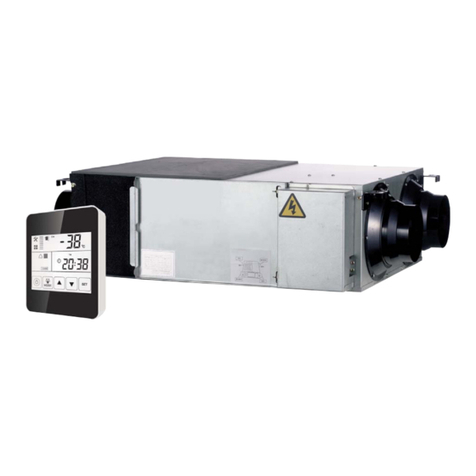
Haier
Haier HACI-RP Series Installation, use and maintenance manual

Salda
Salda RIRS 400VE EKO 3.0 Technical manual
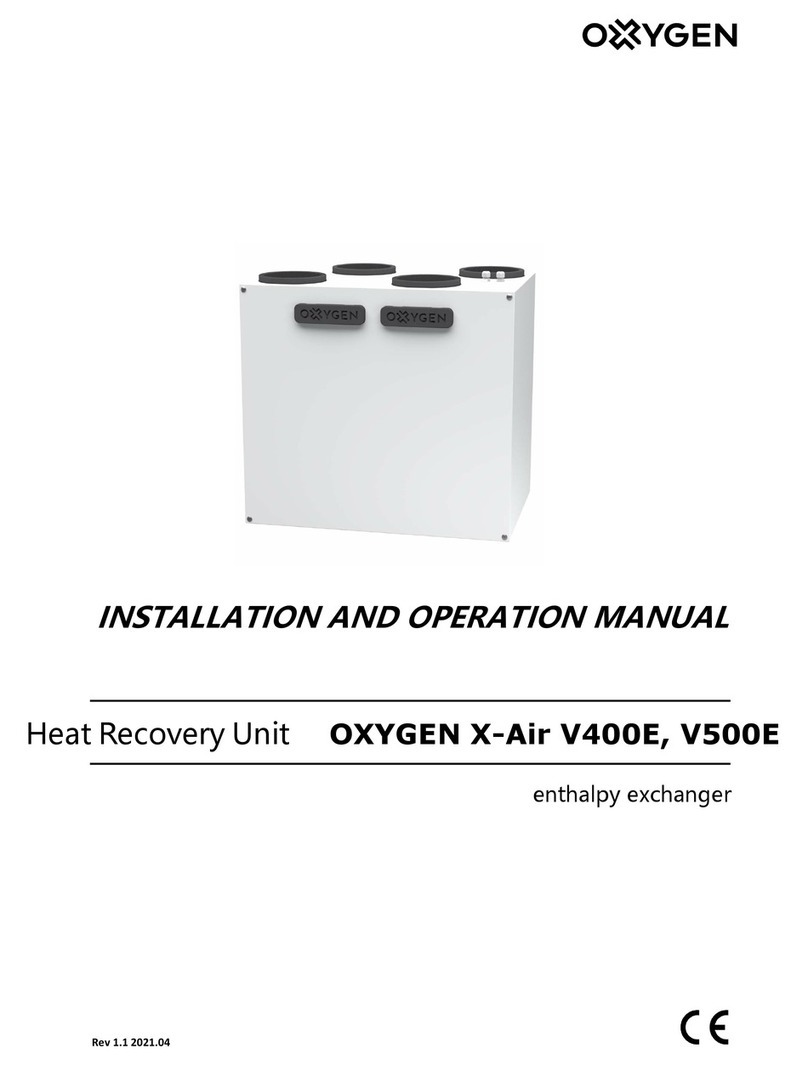
Oxygen
Oxygen X-Air V500E Installation and operation manual
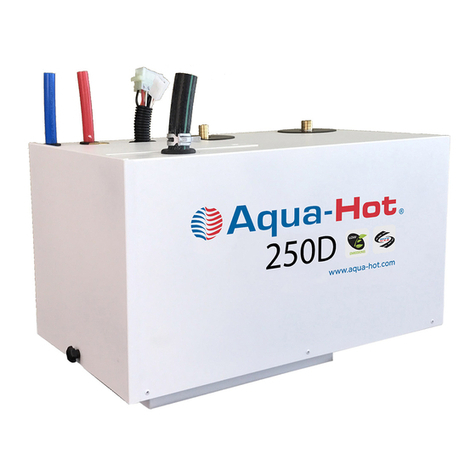
Airxcel
Airxcel Aqua-Hot 200 Series Service manual
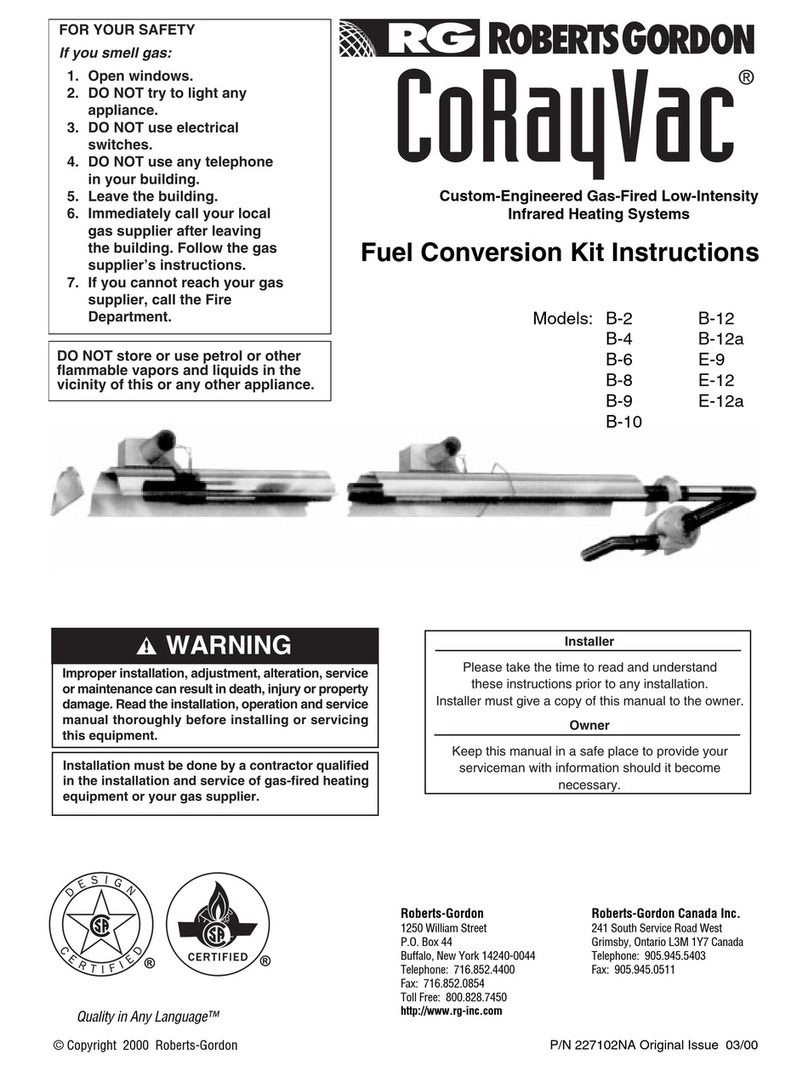
Roberts Gorden
Roberts Gorden CoRayVac B-2 instructions

VOKERA
VOKERA Linea User instructions
